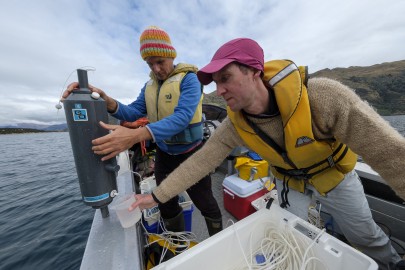
Phil Novis and Marc Schallenberg collect water from 15 m depth in Lake Wanaka, using a Van Dorn sampler. The sample contains lake snow
and its causative agent, Lindavia intermedia.
Following detection of L. intermedia at Nelson’s Lake Rotoiti in 2019, Manaaki Whenua’s Dr Phil Novis has spent the past year working with the Tasman District Council to get a better understanding of the threat it poses to the clear, high-water-quality lakes in the Nelson district.
This project used molecular methods developed during a three-year project, supported by MBIE’s Endeavour Fund, to create new rapid-screening tools to detect the presence of lake snow. Sampling in the Nelson Lakes National Park was funded by Envirolink and Tasman District Council and carried out with field support from the Department of Conservation. Samples were collected every six weeks between June 2020 and May 2021 at two sites at Lakes Rotoiti and Rotoroa.
While lake snow was not detected, the sampling did confirm the invasive alga is present in both of the Nelson Lakes National Park lakes. Sampling has also detected L. intermedia in Nelson City’s Maitai Reservoir. Council-funded work on understanding the dynamics of L. intermedia populations in the Maitai Reservoir and the risk of lake snow development is ongoing.
The good news from wider sampling was that a large number of vulnerable lakes are currently free of detectable L. intermedia (and therefore lake snow), probably only because they are inaccessible.
There is no known control or eradication method for lake snow. While the alga is not toxic to humans or livestock, its impact on the ecology and health of the pristine lakes it favours is likely to be significant. The research shows the alga likes cool, deep, nutrient-deficient lakes with low phosphorous concentrations. Results show that cell growth tends to occur in winter, with lake snow synthesis more severe in summer and autumn.
Dr Novis says that a much better understanding of L. intermedia ecology is needed. “Now there are the tools to quantify both the alga and the slime it produces, we have recommended the ongoing monitoring of water quality in the lakes, in the Nelson Lakes specifically, to gauge long-term trends for the alga. This would provide much needed data on lakes in forested catchments that could be useful in future incursions by the species.”

